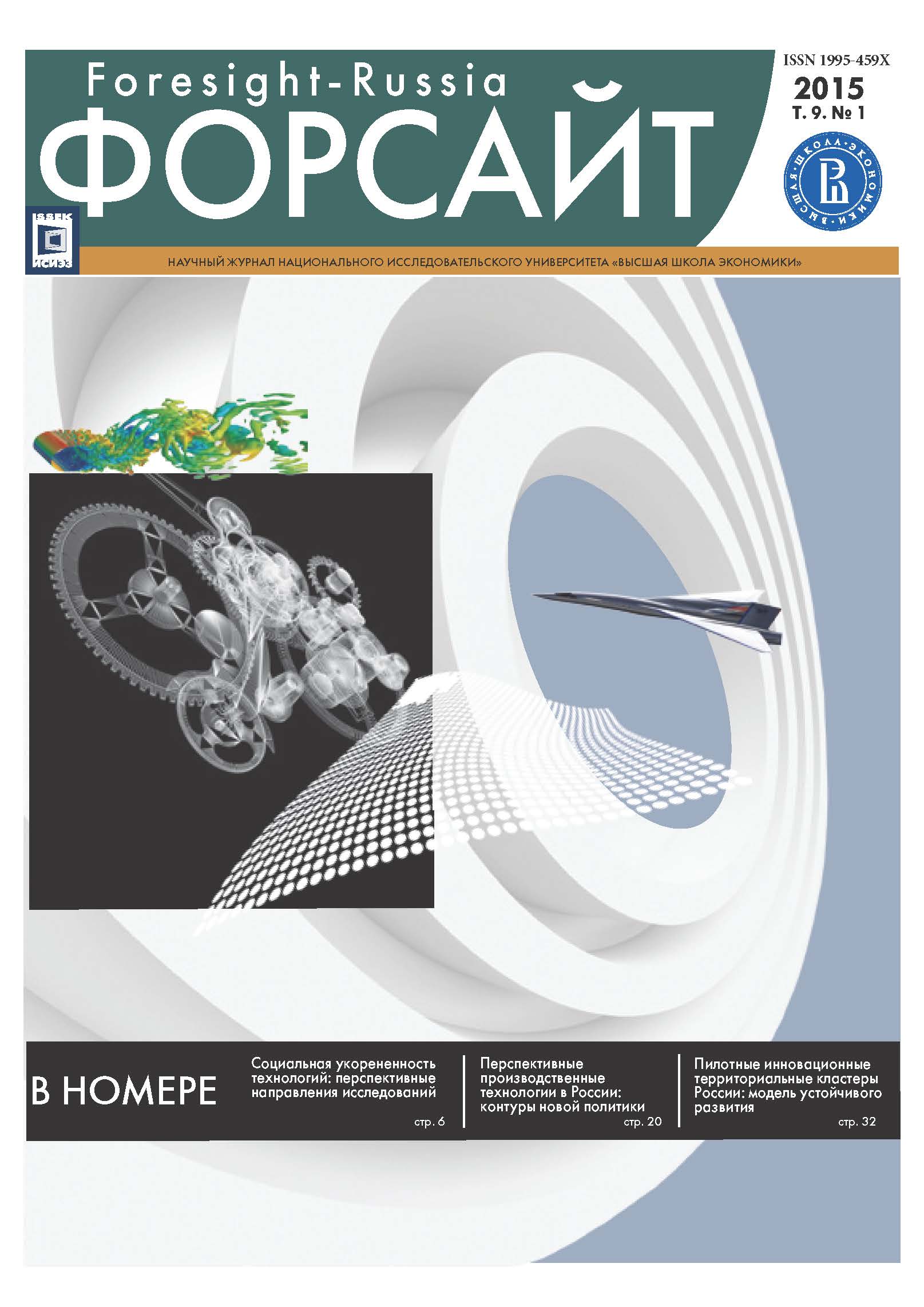Аннотация
Разработке отраслевых программ, особенно в технологических областях, сопутствует высокий уровень неопределенности. Подобные инициативы направлены на создание продуктов, реализация которых начнется лишь через несколько лет, поэтому существует вероятность, что к моменту запуска в массовое производство спрос на них исчезнет ввиду появления более совершенных технологий. В статье описывается комплексный инструментарий, синтезирующий комплементарные функции Форсайта, конкурентной разведки и бизнес-аналитики. Форсайт и конкурентная разведка нацелены в первую очередь на анализ внешней среды, и поэтому среди прочего дают возможность определить тенденции развития рынков и технологий, составить локальный профиль отрасли для идентификации наиболее подходящих политических инструментов. Текущие сигналы, которые идентифицируются с помощью методик конкурентной разведки, могут подтвердить выводы, сделанные в ходе долгосрочных Форсайт-исследований с использованием таких методов, как сценарии, дорожные карты и сканирование. Это позволяет глубже понять факторы риска и разрабатывать более качественную и эффективную отраслевую политику.
Авторами предложен набор индикаторов для мониторинга реализации программ. Система мониторинга дает возможность оперативно вносить необходимые корректировки в программы. Как следствие, не только снижается уровень неопределенности и риска, но и повышается вероятность того, что новые инициативы будут востребованы целевой аудиторией и своевременно выявятся новые возможности развития отрасли. Рассматриваемый подход протестирован на модельном кейсе – разработке государственной программы развития производства инновационных нутрицевтических продуктов в Канаде.
Литература
Ashton B.W., Klavans R.A. (1997) Keeping Abreast of Science and Technology: Technical Intelligence for Business. Columbus, OH: Batelle Press.
Bergeron P. (2000) Government Approaches to Foster Competitive Intelligence Practice in SMEs: A Comparative Study of Eight Governments // Proceedings of the Annual Meeting - American Society for Information Science. Vol. 37. P. 301-308.
Bonthous J. (1995) Understanding intelligence across cultures // Competitive Intelligence Review. Summer/Fall. P. 12-19.
Calof J., Skinner B. (1999) What's Happening in Canada. Government's Role in Competitive Intelligence // Competitive Intelligence Magazine. Vol. 2. № 2. P. 20-23.
Calof J., Smith J. (2010) The integrative domain of foresight and competitive intelligence and its impact on R&D management // R&D Management. Vol. 40. № 1. Р. 31-39.
Calof J.L. (2007) Event Intelligence: Time to Invite Your Government // Competitive Intelligence Magazine. Vol. 10. № 5. Р. 55-57.
Davenport T., Harris J., Morrison R. (2010) Analytics at Work: Smarter Decisions, Better Results. Boston: Harvard Business School Press.
Dedijer S. (1994) Opinion: Governments, Business Intelligence - A Pioneering Report from France // Competitive Intelligence Review. Vol. 5. № 3. Р. 45-47.
Du Toit A.S.A. (2013) Comparative Study of Competitive Intelligence Practices between Two Retail Banks in Brazil and South Africa // Journal of Intelligence Studies in Business. Vol. 2. P. 30-39.
Fehringer D., Hohhof B., Johnson T. (2007) State of the art competitive intelligence. San Antonio, TX: Competitive Intelligence Foundation.
Fleisher C.S., Bensoussan B. (2002) Strategic and competitive analysis: Methods and techniques for analyzing business. Upper Saddle River, NJ: Prentice Hall.
For-Learn (2014) Excerpt from online foresight guide. Режим доступа: http://forlearn.jrc.ec.europa.eu/guide/9_key-terms/foresight.htm, дата обращения 20.06.2014.
Fruchet G. (2009) Effective practices for implementing CTI in large R&D organizations in Competitive Technical Intelligence // The Competitive Technical Intelligence book (vol. 4) / Eds. R. Ashton, B. Hohhof. San Antonio, TX: Competitive Intelligence Foundation. P. 37-54.
GIA (2011) Market Intelligence in Global Organization: Survey Findings in 2011. GIA White Paper 2/2011. Global Intelligence Alliance.
GIA (2013) The State of Market Intelligence in 2013: Global MI Survey findings. GIA White Paper, 2013. Global Intelligence Alliance.
Gilad B. (1998) Business Blindspots. New York: Irwin Professional Publishing.
Hamilton-Pennell C. (2004) CI For Small businesses: The City of Littleton's Economic Gardening program // Competitive Intelligence Magazine. Vol. 7. № 6 (November-December). Р. 46-48.
Herring J. (1993) Business Intelligence: Scientific and Technical Intelligence: The Key to R&D // Journal of Business Strategy. Vol. 14. № 3. Р. 10-12.
IBM (2013) Partnership for Public Service. From Data to Decisions III: Lessons from Early Analytics Programs. Washington, D.C.: IBM Centre for the Business of Government.
Juhari A., Stephens D. (2006) Tracing the origins of competitive intelligence throughout history // Competitive Intelligence Review. Vol 3. № 4. Р. 61-82.
Kahaner L. (1997) Competitive Intelligence: How to Gather, Analyze, and Use Information to Move Your Business to the Top. New York: Simon & Schuster.
Office of the Director of National Intelligence (2014) Foresight and understanding from scientific exposition (FUSE). Режим доступа: http://www.iarpa.gov/index.php/research-programs/fuse, дата обращения 20.06.2014.
Parker D. (2000) Can Government CI Bolster Regional Competitiveness? // Competitive Intelligence Review. Vol. 11. № 4. P. 57-64.
Popper R. (2008) How are foresight methods selected? // Foresight. Vol. 10. № 6. Р. 62-89.
Provost F., Fawcett Т. (2013) Data Science for Business: What you need to know about data mining and data-analytic thinking. Cambridge: O’Reilly Media.
SCIP (2004) Proceedings: 9th Annual European Conference, 27-29 October, Milan, Italy. San-Antonio, TX: Society of Competitive Intelligence Professionals.
SCIP (2014) FAQ’s. Режим доступа: www.scip.org/re_pdfs/1395928684_pdf_FrequentlyAskedQuestions.pdf, дата обращения 17.06.2014.
Salvador M.R., Salinas Casanova L.F. (2013) Applying Competitive Intelligence: The Case of Thermoplastics Elastomers // Journal of Intelligence Studies in Business. Vol. 3. P. 47-53.
Saritas O., Smith J. (2008) Big Picture Foresight Survey Results and Implications. Paper presented at Future-oriented Technology Analysis (FTA) Conference 2008, Seville.
Smalla H., Boyack K., Klavans R. (2014) Identifying emerging topics in science and technology // Research Policy. Vol. 43. № 8. P. 1450-1467.
Smith J., Saritas O. (2011) Science and technology foresight baker's dozen: A pocket primer of comparative and combined foresight methods // Foresight. Vol. 13. № 2. Р. 79-96.
Watson K. (1997) Intelligence gathering: Scanning, mind maps and scenarios // Optimum. Vol. 27. № 2. Р. 69-74.
Wolfe J. (2005) Safer and guilt-free nano foods // Forbes Magazine, September 8. Режим доступа: www.forbes.com/2005/08/09/nanotechnology-kraft-hershey-cz_jw_0810soapbox_inl.html, дата обращения 20.06.2014.
Wright S., Calof J. (2006) The Quest for Competitive Business and Marketing Intelligence: A Country Comparison of Current Practices // European Journal of Marketing. Vol. 40. № 5-6. Р. 453-465.
Xu K., Liao S.S., Ki J., Song Y. (2011) Mining comparative opinions from customer reviews for competitive intelligence // Decision Support Systems. Vol. 50. № 4. Р. 743-754.

Это произведение доступно по лицензии Creative Commons «Attribution» («Атрибуция») 4.0 Всемирная.

